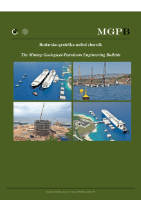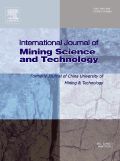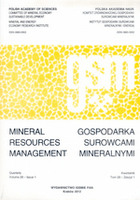
Eurasian Mining
Scope & Guideline
Transforming insights into actions for the mining sector.
Introduction
Aims and Scopes
- Mining Technology and Engineering:
This area encompasses studies that explore innovative mining techniques, equipment design, and operational efficiency improvements to enhance productivity and safety in mining operations. - Resource Management and Sustainability:
Research in this scope addresses the sustainable management of mineral resources, including the evaluation of secondary resources, waste management, and ecological restoration efforts in mining regions. - Geomechanical and Geological Assessments:
This includes geomechanical modeling, stress-strain analysis, and geological studies aimed at understanding the subsurface behavior of materials, which is crucial for safe and efficient mining operations. - Environmental Impact and Monitoring:
This focus area investigates the environmental impacts of mining activities, including pollution control, waste management, and the use of remote sensing technologies for environmental monitoring. - Economic and Policy Analysis:
This involves exploring the economic implications of mining practices, regulatory frameworks, and the socio-economic impacts of mining in emerging economies.
Trending and Emerging
- Sustainable Mining Practices:
There is an increasing focus on research that promotes sustainability in mining practices, emphasizing the need for ecological balance and the responsible use of resources. - Advanced Monitoring and Modeling Techniques:
Emerging themes include the use of advanced monitoring technologies and modeling techniques, such as 3D modeling and geomechanical assessments, to enhance operational efficiency and safety. - Integration of Digital Technologies in Mining:
The integration of digital tools and technologies, such as data analytics and artificial intelligence, is becoming a focal point, reflecting the industry's move towards smarter and more efficient mining operations. - Environmental Remediation and Waste Management:
Research on the reuse of mining waste and the development of environmentally friendly materials is gaining traction, highlighting the industry's commitment to reducing its ecological footprint. - Policy and Economic Resilience in Mining:
There is a growing interest in understanding the economic resilience of the mining sector in the face of global challenges, including energy transitions and regulatory changes.
Declining or Waning
- Traditional Mineral Processing Techniques:
Research related to conventional mineral processing methods appears to be decreasing, possibly due to a shift towards more innovative and sustainable processing technologies. - Geological Exploration in Established Regions:
There seems to be a waning interest in geological exploration studies focused on well-established mining regions, as researchers turn towards emerging areas or unconventional resources. - Conventional Economic Models of Mining:
Traditional economic analyses of mining operations are being overshadowed by more complex models that consider sustainability and environmental impacts, leading to a decline in straightforward economic assessments.
Similar Journals

MINERALS ENGINEERING
Empowering the Future of Engineering Through ResearchMINERALS ENGINEERING, an esteemed journal published by PERGAMON-ELSEVIER SCIENCE LTD, is at the forefront of disseminating cutting-edge research in the fields of minerals processing, geotechnical engineering, and control systems. Since its inception in 1988, this journal has become a pivotal platform for researchers, professionals, and students alike, offering insights and advancements that contribute significantly to both academia and industry. With a strong emphasis on interdisciplinary approaches, MINERALS ENGINEERING is ranked in the top quartile (Q1) for multiple engineering categories, including Mechanical Engineering and Geotechnical Engineering, highlighting its relevance and influence in the global scientific community. Although not an open access journal, it provides comprehensive analyses and robust methodologies that are critical for advancing technological innovations and environmental sustainability within engineering. Researchers can rely on this journal to stay informed about the latest developments, trends, and challenges they face in the field, ensuring they are at the forefront of minerals engineering research.

Mining Technology-Transactions of the Institutions of Mining and Metallurgy
Connecting Ideas for a Sustainable Mining FutureMining Technology - Transactions of the Institutions of Mining and Metallurgy, published by SAGE Publications Inc., serves as a pivotal platform for disseminating cutting-edge research in the fields of mining and metallurgy. With an ISSN of 2572-6668 and E-ISSN 2572-6676, this esteemed journal has established a notable presence in the academic community, particularly in Geology (Q2) and Geotechnical Engineering and Engineering Geology (Q3) as of 2023. The journal boasts an impressive Scopus ranking, placing it among the top research outlets in its category with Earth and Planetary Sciences _ Geology ranked #170/321 and Geotechnical Engineering and Engineering Geology at #129/229. While it operates under a traditional access model, its dedication to the advancement of knowledge within the mining sector is evident through its converging themes from 2018 to 2024, emphasizing innovation, sustainability, and safety in mining practices. This journal is essential for researchers, professionals, and students seeking to stay at the forefront of developments in the mining industry.

Rudarsko-Geolosko-Naftni Zbornik
Illuminating Paths in Mining, Geology, and PetroleumRudarsko-Geolosko-Naftni Zbornik, the esteemed journal published by the University of Zagreb's Faculty of Mining, Geology and Petroleum Engineering, serves as a vital platform for advancing knowledge in the fields of Earth sciences, energy, and geology. With an ISSN of 0353-4529 and an E-ISSN of 1849-0409, this open-access journal has been disseminating high-quality research since 1989, contributing significantly to scientific discourse in Croatia and beyond. As of 2023, it holds an impressive categorization in various quartiles, notably achieving Q2 in Earth and Planetary Sciences and Q3 in several related domains, showcasing its relevance and impact within the academic community. The journal's commitment to quality is reflected in its Scopus rankings, placing it in competitive positions across diverse disciplines. Researchers, professionals, and students alike will find invaluable resources and insights that foster innovation and collaboration in their respective fields, making Rudarsko-Geolosko-Naftni Zbornik an essential read for those dedicated to exploring the complexities of natural resources and environmental challenges.

International Journal of Mining Science and Technology
Exploring the Future of Geotechnical Engineering and SustainabilityThe International Journal of Mining Science and Technology, published by ELSEVIER, is a premier open access journal that has been at the forefront of disseminating groundbreaking research in the fields of mining science, geotechnical engineering, and environmental sustainability since its inception in 2012. With a commendable impact factor and distinguished quartile rankings—including Q1 status in Energy Engineering, Geochemistry and Petrology, and Geotechnical Engineering—this journal stands as a vital resource for researchers, professionals, and students alike. The journal's commitment to open access since 2017 ensures that the latest advancements in mining techniques, energy solutions, and geological innovations are readily available to the global research community. With consistently high rankings in Scopus and a strong percentile performance, the International Journal of Mining Science and Technology plays a crucial role in shaping the future of mining and earth sciences, making it a must-read for anyone involved in these dynamic fields.

Visnyk of Taras Shevchenko National University of Kyiv-Geology
Uncovering the Depths of Geology through Academic ExcellenceVisnyk of Taras Shevchenko National University of Kyiv-Geology is a premier academic journal dedicated to advancing the field of geology and related earth sciences. Published by the esteemed NATL TARAS SHEVCHENKO UNIV KYIV, this journal serves as a vital platform for researchers, professionals, and students to disseminate original research findings, innovative methodologies, and comprehensive reviews that address contemporary geological challenges. With an ISSN of 1728-2713 and an E-ISSN of 2079-9063, the journal is committed to upholding rigorous academic standards and excellence, although it currently operates without an open access model. The Visnyk primarily focuses on topics such as mineralogy, geophysics, geological engineering, and environmental geology, thus providing a broad spectrum of insights into the ever-evolving discipline of geology. Situated in Kyiv, Ukraine, it not only fosters local research but also contributes to the global geological discourse, making it an indispensable resource for anyone engaged in earth sciences.

Gospodarka Surowcami Mineralnymi-Mineral Resources Management
Uncovering Insights for Sustainable Resource PracticesGospodarka Surowcami Mineralnymi-Mineral Resources Management is a pivotal academic journal published by the Polish Academy of Sciences and the Mineral and Energy Economics Research Institute. Focusing on the field of Economic Geology, this journal plays a critical role in disseminating research on mineral resources management, exploring the economic implications of mineral exploitation, sustainability practices, and technological advancements in resource extraction. With an ISSN of 0860-0953 and an E-ISSN of 2299-2324, the journal has established itself as a respected source of knowledge, holding a Q3 ranking in its category as of 2023 and demonstrating its relevance within a competitive landscape where it ranks 22nd out of 43 in Economic Geology according to Scopus. Researchers, professionals, and students will find this journal to be an invaluable resource for the latest insights and developments in mineral resource management, contributing significantly to the overarching conversations in geology and environmental science.

Journal of Mining and Environment
Pioneering research at the nexus of mining and ecology.Journal of Mining and Environment, published by Shahrood University of Technology, is a pivotal peer-reviewed journal dedicated to advancing the fields of geochemistry, petrology, geophysics, geotechnical engineering, and pollution studies. With its ISSN 2251-8592 and E-ISSN 2251-8606, this journal aims to disseminate significant research findings that address critical environmental challenges associated with the mining industry. Operating out of Iran, the journal has quickly established itself in the academic arena, achieving a Q3 quartile ranking across multiple categories in 2023, highlighting its contribution to the scientific community's understanding of mining-related environmental impacts. Accessible to researchers, professionals, and students, the journal emphasizes open dialogue and interdisciplinary collaboration, focusing on innovative methodologies and sustainable practices that can shape the future of mining and environmental stewardship. With a commitment to quality and relevance, the Journal of Mining and Environment is an essential resource for anyone engaged in the crucial intersection of mining processes and environmental integrity, encouraging submissions that push the boundaries of current knowledge.

Journal of the Southern African Institute of Mining and Metallurgy
Fostering Collaboration in Metallurgical Sciences.The Journal of the Southern African Institute of Mining and Metallurgy (ISSN: 2225-6253; E-ISSN: 2411-9717), published by the Southern African Institute of Mining and Metallurgy, stands as a pivotal resource in the fields of mining and metallurgy, with a particular focus on geotechnical engineering and materials chemistry. Since its inception in 1969, this Open Access journal has aimed to disseminate high-quality research that addresses pressing challenges and innovations within these industries. With its categorization in the Q3 quartile for 2023 across multiple disciplines, including Geotechnical Engineering, Materials Chemistry, and Metals and Alloys, the journal has established a notable presence in the academic community. Researchers and practitioners can explore a wide array of studies and insights, enhancing their understanding of new methodologies and advancements. Based in South Africa, this journal not only reflects regional developments but also connects with global trends, making it an essential platform for knowledge exchange among researchers, professionals, and students eager to contribute to the advancement of mining and metallurgical sciences.

JOURNAL OF MINING SCIENCE
Pioneering Research in Geology and Geotechnical EngineeringJOURNAL OF MINING SCIENCE, published by PLEIADES PUBLISHING INC, is a leading platform for research and development in the fields of geology, geotechnical engineering, and engineering geology. With an ISSN of 1062-7391 and E-ISSN of 1573-8736, this journal has established itself as a notable contributor to the mining and earth sciences communities since its inception in 1991. The journal is indexed in prestigious databases and currently holds a Q3 ranking in both geology and geotechnical engineering categories, recognizing the impact and quality of the research it publishes. Although it does not offer open access, it provides extensive insights from cutting-edge studies that appeal to researchers, professionals, and students alike. The Journal of Mining Science aims to disseminate significant advancements in mining technology and its environmental implications, promoting sustainability and innovation within the industry. With its comprehensive scope and commitment to excellence, this journal serves as an invaluable resource for stakeholders in academia and industry striving to enhance their knowledge and practices in mining science.

Journal of Mining Institute
Transforming Challenges into Opportunities in Earth SciencesThe Journal of Mining Institute, published by SAINT-PETERSBURG MINING UNIVERSITY, stands as a premier platform for disseminating cutting-edge research in the fields of Economic Geology, Geology, and Geotechnical Engineering. With an impressive Q1 ranking in various quartiles for 2023, this journal offers enlightening insights into earth sciences, reflecting its substantial impact within the academic community. The journal, accessible in open access format since 1975, ensures that researchers, professionals, and students can readily access high-quality research articles. The ISSN for the print version is 2411-3336 and E-ISSN 2541-9404, supporting its reach both online and offline. As it converges knowledge from 2017 to 2024, the Journal of Mining Institute serves as an essential resource for understanding contemporary challenges and innovations in mining and geology, encouraging a collaborative exploration of sustainable practices and technological advancements in these critical fields.